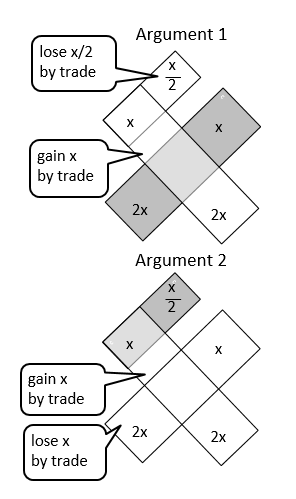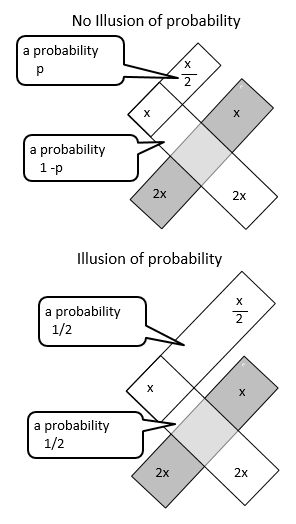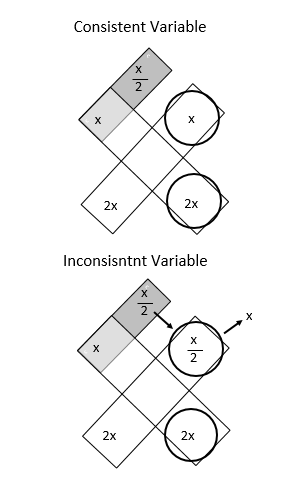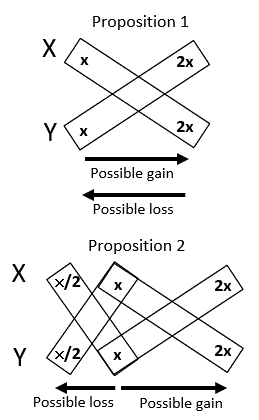Return to the list of my pages written in English about the two envelopes problem
In an abbreviated form, these arguments are as follows.

The authors may have same interpretation of the problem as I have.
SinglePairans say that they felt their paradox (SinglePairan's paradox) when they thought their problem (SinglePairian's problem).
(The explanation of these problems is written in "Two kinds of 'Two envelopes problem'".)

Each of the phrases "possible gain" and "possible loss" have context dependent meanings.
But we fallaciously think that they have some clear meanings and it is very hard to notice that they have no meanings without a particular context.
Fallacy of equivalence of the contexts
The argument 1 and the argument 2 have very different contexts each other.
The phrase "Let x be the amount of money in the chosen envelope" in the argument 1 makes a particular context.
And the phrase "Let d be the difference of amounts of money in the two envelopes" in the argument 2 makes another context.
But we fallaciously think that they make no context and it is very hard to notice that they make different contexts.
The sample space S ={ (100, 200), (200, 100), (200, 400), (400, 200), (400, 800), (800, 400) }.
Then each context of the two arguments is as follows.
Case of the argument 1
The context of the argument 1 ={ { (200, 100), (200, 400) }, { (400, 200), (400, 800) } }.
In this context, the phrases "possible gain" and "possible loss" both have meaning, and only proposition 1 is true.
Case of the argument 2
The context of the argument 2 ={ { (100, 200), (200,100)) }, {(200, 400), (400, 200) }, { (400, 800), (800, 400) } }.
In this context, the phrases "possible gain" and "possible loss" both have meaning, and only proposition 2 is true.
Case of another context
An context which is differ from both of above contexts ={ { (100, 200), (400, 200)) }, {(200, 400), (800, 400) } }.
In this context, the phrases "possible gain" and "possible loss" both have meaning, and the two propositions are both false.
The author might have noticed the fallacy of context independence of the words.
Albers, C. J., Kooi, B. P., & Schaafsma, W. (2005).
The authors might have noticed one or two of these fallacies.
By the following reasons, I expect that the fallacy of equivalence of the contexts is the root cause.
In my opinion, if we write the two propositions in a more mathematical form, we will notice that these propositions are saying about different subjects.
It has become more apparent that the two propositions are saying about different subjects.
It has become obvious that the two propositions are saying about different subjects.
I think that the words "gain" and "loss" let us think by daily logic and they prevent us from mathematical thinking.
I found that if we write the two propositions in a graphical form, it is very easy to recognise that these propositions are saying about different subjects.
Return to the list of my pages written in English about the two envelopes problem
2017/03/01 20:47:37
First edition 2015/01/12
Smullyan's paradox on the two envelopes problem
Caution
I who am a Japanese wrote this page in English, but I am not so good at English.
I who am a Japanese wrote this page in English, but I am not so good at English.
Smullyan's paradox
In Smullyan, Raymond (1992). , two contradictory propositions about two envelope problem are proven.- Proposition 1
The amount you will gain by trading, if you do gain, is greater than the amount you will lose, if you do lose.
- Proposition 2
The two amounts are really the same.
In an abbreviated form, these arguments are as follows.
- Argument 1 (proof of proposition 1)
Let x be the amount of money in the chosen envelope.
Possible gain by trading is x and possible loss is x/2.
Therefore possible gain by trading is greater than possible loss by trading.
- Argument 2 (proof of proposition 2)
Let d be the difference of amounts of money in the two envelopes.
Possible gain by trading is d and possible loss is d.
Therefore possible gain is equal to possible loss.
The mathematical structure of the Smullyan's paradox
Case of my interpretation
I have following interpretation about the Smullyan's paradox.Case of Albers, C. J., Kooi, B. P., & Schaafsma, W. (2005).
In the section titled 'EXPLORATIONS' of this article, the ambiguity of the terms 'the amount you will gain by trading, if you do gain' and 'the amount you will lose by trading if you do lose' is pointed out.The authors may have same interpretation of the problem as I have.
Relation between the mathematical structure of the two envelope paradox and the mathematical structure of the Smullyan's paradox
DoublePairans like me feel DoublePairan's paradox when they think DoublePairian's problem.SinglePairans say that they felt their paradox (SinglePairan's paradox) when they thought their problem (SinglePairian's problem).
(The explanation of these problems is written in "Two kinds of 'Two envelopes problem'".)
Mathematical structure of DoublePairian's paradox
Mathematical structure of SinglePairian's paradox
Relation between the mathematical structures
Seeing the above figures, I have noticed that the structure of the SinglePairian's paradox and the structure of the Smullyan's paradox are alike.Fallacies which cause the Smullyan's paradox
On January 17, 2015, this paragraph was added.There are two fallacies which cause the paradox
Fallacy of context independence of the wordsEach of the phrases "possible gain" and "possible loss" have context dependent meanings.
But we fallaciously think that they have some clear meanings and it is very hard to notice that they have no meanings without a particular context.
Fallacy of equivalence of the contexts
The argument 1 and the argument 2 have very different contexts each other.
The phrase "Let x be the amount of money in the chosen envelope" in the argument 1 makes a particular context.
And the phrase "Let d be the difference of amounts of money in the two envelopes" in the argument 2 makes another context.
But we fallaciously think that they make no context and it is very hard to notice that they make different contexts.
Example of the contexts
I will use following terminologies.- (a, b) denotes that the amount of money in the chosen envelope is a and the amount in the other envelope is b.
- I call (a,b) the sample-point (element in the sample space).
- { sample-point1, sample-point2, … } denotes an event.
- { event1, event2, … } denotes a context.
The sample space S =
Then each context of the two arguments is as follows.
Case of the argument 1
The context of the argument 1 =
In this context, the phrases "possible gain" and "possible loss" both have meaning, and only proposition 1 is true.
Case of the argument 2
The context of the argument 2 =
In this context, the phrases "possible gain" and "possible loss" both have meaning, and only proposition 2 is true.
Case of another context
An context which is differ from both of above contexts =
In this context, the phrases "possible gain" and "possible loss" both have meaning, and the two propositions are both false.
Some people might have noticed these fallacies
Chase, J. (2002).The author might have noticed the fallacy of context independence of the words.
Albers, C. J., Kooi, B. P., & Schaafsma, W. (2005).
The authors might have noticed one or two of these fallacies.
Which fallacy is the root cause of the Smullyan's paradox?
On January 17, 2015, this paragraph was added.By the following reasons, I expect that the fallacy of equivalence of the contexts is the root cause.
- The fallacy of context independence of the words might be the result of this fallacy.
- This fallacy might be one of the cause of the thinking of the advocators of the theory of
"E = (1/2)2a + (1/2)a " on The Two Envelope Paradox.
↑ Revised on March 13, 2016.
Mathematical form of these propositions
On March 13, 2016, this paragraph was added.In my opinion, if we write the two propositions in a more mathematical form, we will notice that these propositions are saying about different subjects.
Literal translation to mathematical form
- Proposition 1
Let s be the amount of money in the chosen envelope,
and let possible gain g1 and possible loss l1 be as follows.Then if g1(s) and l1(s) are both definedg1(s) = s
undefined(if s can be the lesser amount)
(otherwise)l1(s) = s/2
undefined(if s/2 can be the lesser amount)
(otherwise).g1(s) > l1(s)
- Proposition 2
Let s be the amount of money in the chosen envelope,
and let o be the amount of money in the other envelope,
and let possible gain g2 and possible loss l2 be as follows.Then if g2(s) and l2(s) are both defined
( ↑ revised on March 14, 2016)g2(s) = d
undefined(if | o - s | = d and o > s)
(otherwise)l2(s) = d
undefined(if | o - s | = d and o < s)
(otherwise).g2(s) = l2(s) .
It has become more apparent that the two propositions are saying about different subjects.
Refinement to more simple but mathematically equivalent form
- Proposition 1
If m and m/2 both can be lesser amount of money then m > m/2.
- Proposition 2
If(m, m + d) can be a pair of amounts of money then(m + d) - m = - (m - (m + d)) .
( ↑ revised on March 14, 2016)
It has become obvious that the two propositions are saying about different subjects.
my conjecture
In mathematical form, the two propositions are quite unlike from each other.I think that the words "gain" and "loss" let us think by daily logic and they prevent us from mathematical thinking.
Graphical form of these propositions
On May 27, 2016, this paragraph was added.I found that if we write the two propositions in a graphical form, it is very easy to recognise that these propositions are saying about different subjects.
A graphical form
Reffernce
-
Albers, C. J., Kooi, B. P., & Schaafsma, W. (2005).
Trying to resolve the two-envelope problem. Synthese, 145(1), 89-109.
-
Chase, J. (2002).
The non-probabilistic two envelope paradox. Analysis, 157-160.
-
Smullyan, Raymond (1992).
Satan, Cantor, and infinity and other mind-boggling puzzles.
Alfred A. Knopf. pp. 189–192. ISBN 0-679-40688-3.
日本語訳「スマリヤンの無限の論理パズル : ゲーデルとカントールをめぐる難問奇問」
レイモンド・スマリヤン著 ; 長尾確訳. 白揚社
Return to the list of my pages written in English about the two envelopes problem